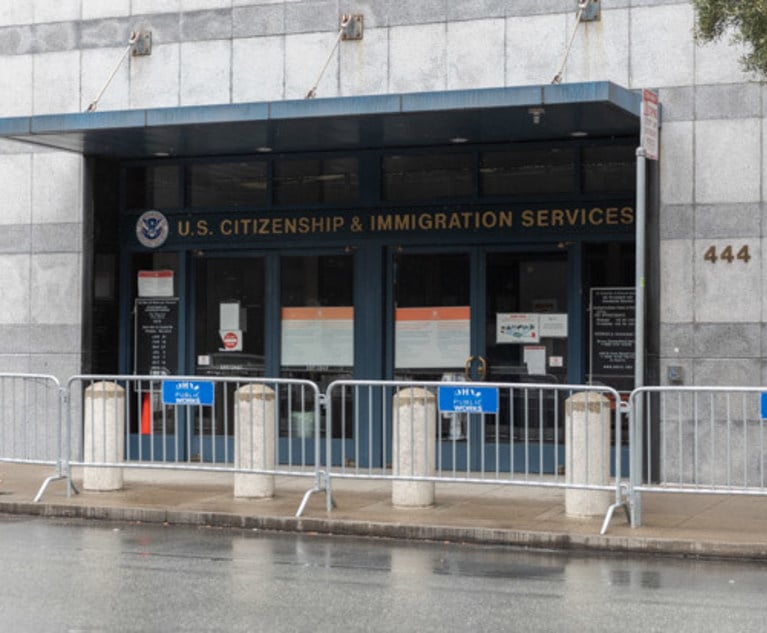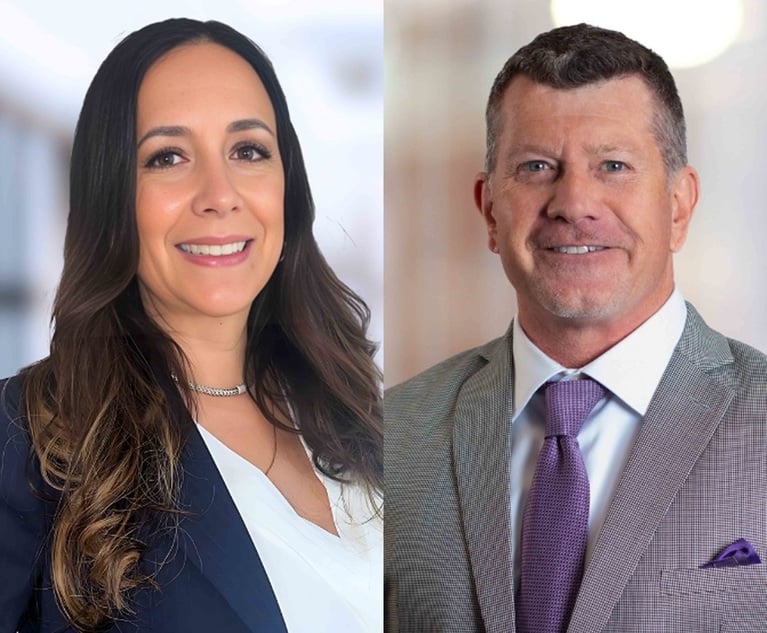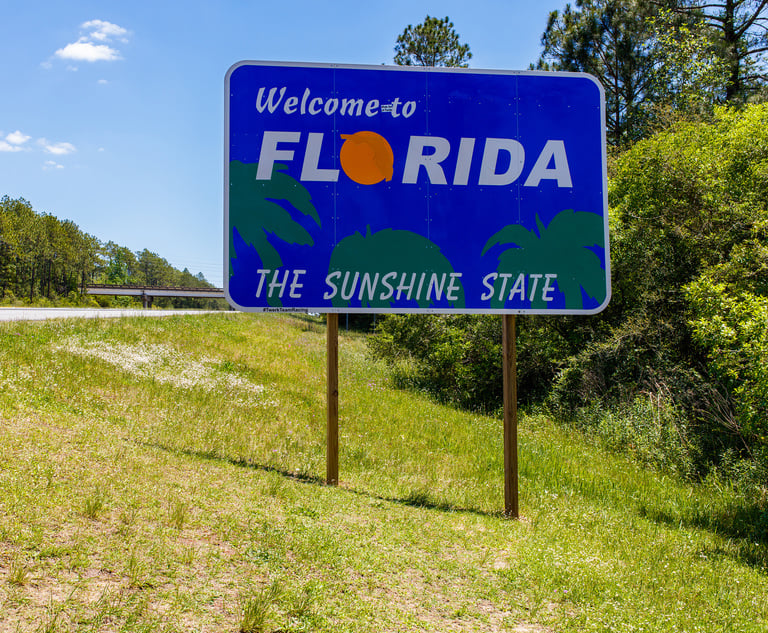 Steve Marks and Peter Prieto, Podhurst Orseck
Steve Marks and Peter Prieto, Podhurst OrseckPodhurst Orseck: Litigation Boutique With Focus on Class Actions, MDLs, Aviation
The Miami law firm is a small, tight-knit group of attorneys accustomed to playing on the national and international stage.
September 10, 2019 at 09:36 AM
11 minute read
Podhurst Orseck was founded in Miami more than half a century ago by two friends, Aaron Podhurst and Bobby Orseck. Podhurst was the trial lawyer, and Orseck handled the appellate work. Orseck tragically drowned in Israel in 1978. Podhurst, to this day, practices law full time.
From its founding in 1967, Podhurst Orseck has remained a firm of no more than 15 or so lawyers. We are exclusively a trial and appellate litigation boutique. Over the years, Podhurst Orseck has attained a global reputation for representing the families of victims of aircraft accidents and a national reputation for doing high-stakes litigation in class action and mass tort, including multidistrict litigation.
Podhurst Orseck, on a day-to-day basis, is managed by Steve Marks and Peter Prieto with advice and counsel from Podhurst. But virtually every significant business decision is made with input from all of the partners and associates. For example, every lawyer has a say in the firm's hiring decisions.
Though we are Miami-based, we have built a global practice that consistently competes with large firms around the world. Our attorneys routinely are involved in challenging and complex commercial litigation, aviation, class action, white collar defense, appellate and personal injury cases. For example:
- We serve as lead counsel in the Takata air bag MDL, which has recovered $1.5 billion as part of the largest automotive recall in U.S. history,
- We served on plaintiffs committees guiding the NFL concussion MDL, where a groundbreaking, uncapped settlement exceeding $1 billion was reached,
- We served as class counsel in the nationwide force-placed insurance class action litigation, where settlements totaling in the hundreds of millions of dollars were reached with financial institutions accused of placing high-priced homeowner insurance policies on mortgages in exchange for kickbacks from insurers,
- We serve as lead counsel in the bank overdraft MDL, where the country's largest banks paid in excess of $1 billion to settle claims of overcharging customers,
- Our firm's expertise in aviation litigation can be traced back to a single event — the 1972 crash of Eastern Airlines Flight 401 in the Florida Everglades, which killed 101 people and injured dozens. We served as lead class counsel for the victims. Since then, Podhurst Orseck has represented victims in more than 150 crashes and air disasters, and have handled more plaintiffs aviation cases than any other law firm in the Southeast.
- The firm represents dozens of families in the Lion Air Flight 610 and Ethiopian Flight 302 airline crashes involving the Boeing 737 Max.
- We serve on the plaintiff's leadership committee of the Blue Cross Blue Shield MDL alleging the health insurer conspired to fix prices and allocate territories.
Firm: Podhurst Orseck
Firm leaders: Aaron S. Podhurst, founding partner; Steve C. Marks, managing partner; Peter Prieto, head of commercial litigation and class action practice
Head count: 16 attorneys, not including temporary or contract attorneys
Location: Miami
Practice areas: Trial and appellate litigation including aviation, personal injury, products liability, class actions and complex commercial litigation
Do you offer alternative fee arrangements?
Yes. While alternative fee arrangements are a novel concept for most firms, they are fairly routine at Podhurst Orseck because more than half of our cases — both personal injury and commercial litigation — are contingency-fee based. Because of our familiarity with alternative fee arrangements, we are able to develop creative arrangements that align our firm's interests with those of our clients. As a result, when our clients succeed, we succeed. Clients are attracted to this because while some firms pay lip service to alternative fee arrangements, we deal with them on a daily basis.
What do you view as the two biggest opportunities for your firm, and what are the two biggest threats?
One of the opportunities we have seen is the ability to partner with other law firms who may need either our expertise or resources to bring and prosecute a significant case. Our relationship with these firms is very important to us.
As a firm, we've also been open to taking calculated risks where we see opportunity for growth. One was handling overseas airline crash cases even as U.S. courts expressed a growing reluctance to hear them. Most aviation law firms were unwilling to represent victims of foreign crashes in U.S. or foreign courts. We decided it would be a challenge and perhaps a little risky, but worth it.
The decision helped position Podhurst Orseck as a go-to firm in the event of a crash anywhere in the world. We have the legal expertise, we have the experts, and we have the knowledge of the products. Now, people from all over the world call us when there's an international accident, asking, "Would you be willing to get involved." We've built a global network of partner law firms as a result.
One of our biggest threats concerns access to the courts. The broad application of the doctrine of forum non conveniens, for example, continues to deny access to U.S. courts to personal injury victims, including U.S. citizens. Similarly, the requirement in federal court that a complaint state a plausible claim has been interpreted by some courts so restrictively that sometimes a plaintiff is essentially required to prove — as opposed to simply allege — his case at the pleading stage without the benefit of any discovery.
Another significant threat is the constant narrowing by certain courts of the claims that our clients are able to bring to recover for their injuries. The class action device — though still found in the rule books in both federal and state law — continues to be whittled down and eliminated through arbitration clauses that are buried and no one ever reads.
The legal market is so competitive now — what trends do you see, and has anything, including alternative service providers, altered your approach? Is your chief competition other mid-market firms, or is your firm competing against big firms for the same work?
The biggest trend we see is the importance of technology to deal with the large amount of e-discovery that is part of any sizable litigation. Artificial intelligence and technology assisted review, or TAR, is changing the way law firms deliver services in more efficient and effective ways. We have adapted to that trend by using TAR for key cases and by the strategic and temporary hiring of contract attorneys when a particular case requires it. That permits us to raise our overhead temporarily but only when necessary.
While the majority of our firm's practice is focused on representing plaintiffs, particularly personal injury victims and consumers, a significant portion of it involves the representation of several key, corporate defendants, including local businesses, law firms and accounting firms. As a result, we compete not only with other litigation boutiques but in some cases with larger firms.
There is much debate around how law firms can foster the next generation of legal talent. What advantages and disadvantages do midsize firms have in attracting and retaining young lawyers, particularly millennials?
Over the years, we have had at least two significant advantages in attracting young talent.
First, is the reputation of Podhurst Orseck — built over half a century — for doing sophisticated and impactful legal work. In the unfortunate case that an aviation accident occurs anywhere in the world, Podhurst Orseck is very likely to receive a call by one or more of the victims' family. This is not meant as a boast, but as fact.
Second is our emphasis that all of our lawyers get involved with their communities or their profession. We encourage this and have led by example, starting with Aaron Podhurst and Bob Josefsberg, both of whom are recognized for their community and nonprofit work as much as they are for their work in the courtroom. And that's why our lawyers, no matter their level, are involved in the arts, bar organizations, and educational and civic institutions. As a result, Podhurst Orseck as a brand resonates with younger attorneys as both an exceptional law firm to practice law and build a legal career at as well as a cause-related company engaged in community and issue advocacy.
The only difference that we may have from some larger firms is the lack of a formalized training program. We are simply not big enough and frankly don't have the time for a so-called formal program. Instead, our more senior lawyers mentor and supervise our junior lawyers who learn — and learn fast — by handling hearings, taking depositions and participating in trials early on in their careers. Our junior lawyers receive as much responsibility as they can handle. We sometimes tend to describe it as "swim or swim" because sinking is not an option. But we believe that's how young lawyers learn and, more importantly, grow as lawyers.
Does your firm employ any nonlawyer professionals in high-level positions (e.g. COO, business development officer, chief strategy officer, etc.)? If so, why is it advantageous to have a nonlawyer in that role? If not, have you considered hiring any?
We have one nonlawyer professional, our office administrator, Carole Curran, who has been with our firm for decades. Curran handles virtually all of the firm's administrative responsibilities and, as they say, "makes the trains run on time." She is assisted and supported by Victor Mas, who has been with our firm for years, and a team of support staff.
What would you say is the most innovative thing your firm has done recently, whether it be technology advancements, internal operations, how you work with clients, etc.?
After spending years in our office on Flagler Street in downtown Miami, we relocated to the nearby SunTrust building in 2017. The layout and design of our new space fosters openness and communication among the lawyers and staff, and is helping us achieve our goal of becoming a paperless office. The latter has been more difficult to accomplish than the former. Because our casework is global, we have also been making significant investments in litigation technology that allows our attorneys to work in a seamless and efficient manner, regardless of where they are traveling in service to clients.
Does your firm have a succession plan in place? If so, what challenges do you face in trying to execute that plan?
Podhurst Orseck has a succession plan dictated by our lawyers, all of whom come from different generations. It starts with our founder, Podhurst, who along with Josefsberg and Joel Eaton, are senior partners who still enjoy and remain quite active in the practice of law. It is followed by Marks who was mentored by Podhurst and heads our personal injury and aviation practice, and Prieto, a former law school classmate of Marks, who joined the firm a decade ago and heads our firm's class action and commercial litigation practice.
In addition to Marks and Prieto, we have a group of very talented partners, all of whom handle personal injury, commercial litigation and appeals. These include Ricardo Martinez-Cid, a former president of the Cuban American Bar Association, and Stephen Rosenthal, a former law clerk to Circuit Judge Rosemary Barkett, as well as John Gravante and Ramon Rasco. Each of these attorneys has gained valuable mentorship from our senior partners during their time with the firm, and they continually transfer their expertise to their younger peers.
Our rising stars include partners Lea Bucciero and Matthew Weinshall, associates Alissa Del Riego and Kristina Infante as well as several staff attorneys, virtually all of whom came to our firm after completing federal clerkships at the district or appellate court level. We feel that with this blend of experience and younger talent, our future is very bright.
We've been the same size for the past 40 years. The reason is that if you get too big, you lose control, and there is a drop off in quality. You also don't know who your partners are, and you don't even know their wives and husbands and kids. We are a family at our firm in large part because of our family-like structure — that comes from our small size and culture.
This content has been archived. It is available through our partners, LexisNexis® and Bloomberg Law.
To view this content, please continue to their sites.
Not a Lexis Subscriber?
Subscribe Now
Not a Bloomberg Law Subscriber?
Subscribe Now
NOT FOR REPRINT
© 2024 ALM Global, LLC, All Rights Reserved. Request academic re-use from www.copyright.com. All other uses, submit a request to [email protected]. For more information visit Asset & Logo Licensing.
You Might Like
View All
Anticipating a New Era of 'Extreme Vetting,' Big Law Immigration Attys Prep for Demand Surge
6 minute read
Zero-Dollar Verdict: Which of Florida's Largest Firms Lost?

Florida-Based Law Firms Start to Lag, As New York Takes a Bigger Piece of Deals
3 minute read
Trending Stories
- 1So You Want to be a Tech Lawyer? Consider Product Counseling
- 2US District Judge in North Carolina Will Take Senior Status
- 3From 'Confusing Labyrinth' to Speeding 'Roller Coaster': Uncertainty Reigns in Title IX as Litigators Await Second Trump Admin
- 4Critical Mass With Law.com’s Amanda Bronstad: Why Jurors in California Failed to Reach Verdict Over Zantac, Bankruptcy Judge Tables Sanctions Against Beasley Allen Attorney
- 5Jones Day Client Seeks Indemnification for $7.2M Privacy Settlement, Plus Defense Costs
Who Got The Work
Michael G. Bongiorno, Andrew Scott Dulberg and Elizabeth E. Driscoll from Wilmer Cutler Pickering Hale and Dorr have stepped in to represent Symbotic Inc., an A.I.-enabled technology platform that focuses on increasing supply chain efficiency, and other defendants in a pending shareholder derivative lawsuit. The case, filed Oct. 2 in Massachusetts District Court by the Brown Law Firm on behalf of Stephen Austen, accuses certain officers and directors of misleading investors in regard to Symbotic's potential for margin growth by failing to disclose that the company was not equipped to timely deploy its systems or manage expenses through project delays. The case, assigned to U.S. District Judge Nathaniel M. Gorton, is 1:24-cv-12522, Austen v. Cohen et al.
Who Got The Work
Edmund Polubinski and Marie Killmond of Davis Polk & Wardwell have entered appearances for data platform software development company MongoDB and other defendants in a pending shareholder derivative lawsuit. The action, filed Oct. 7 in New York Southern District Court by the Brown Law Firm, accuses the company's directors and/or officers of falsely expressing confidence in the company’s restructuring of its sales incentive plan and downplaying the severity of decreases in its upfront commitments. The case is 1:24-cv-07594, Roy v. Ittycheria et al.
Who Got The Work
Amy O. Bruchs and Kurt F. Ellison of Michael Best & Friedrich have entered appearances for Epic Systems Corp. in a pending employment discrimination lawsuit. The suit was filed Sept. 7 in Wisconsin Western District Court by Levine Eisberner LLC and Siri & Glimstad on behalf of a project manager who claims that he was wrongfully terminated after applying for a religious exemption to the defendant's COVID-19 vaccine mandate. The case, assigned to U.S. Magistrate Judge Anita Marie Boor, is 3:24-cv-00630, Secker, Nathan v. Epic Systems Corporation.
Who Got The Work
David X. Sullivan, Thomas J. Finn and Gregory A. Hall from McCarter & English have entered appearances for Sunrun Installation Services in a pending civil rights lawsuit. The complaint was filed Sept. 4 in Connecticut District Court by attorney Robert M. Berke on behalf of former employee George Edward Steins, who was arrested and charged with employing an unregistered home improvement salesperson. The complaint alleges that had Sunrun informed the Connecticut Department of Consumer Protection that the plaintiff's employment had ended in 2017 and that he no longer held Sunrun's home improvement contractor license, he would not have been hit with charges, which were dismissed in May 2024. The case, assigned to U.S. District Judge Jeffrey A. Meyer, is 3:24-cv-01423, Steins v. Sunrun, Inc. et al.
Who Got The Work
Greenberg Traurig shareholder Joshua L. Raskin has entered an appearance for boohoo.com UK Ltd. in a pending patent infringement lawsuit. The suit, filed Sept. 3 in Texas Eastern District Court by Rozier Hardt McDonough on behalf of Alto Dynamics, asserts five patents related to an online shopping platform. The case, assigned to U.S. District Judge Rodney Gilstrap, is 2:24-cv-00719, Alto Dynamics, LLC v. boohoo.com UK Limited.
Featured Firms
Law Offices of Gary Martin Hays & Associates, P.C.
(470) 294-1674
Law Offices of Mark E. Salomone
(857) 444-6468
Smith & Hassler
(713) 739-1250






